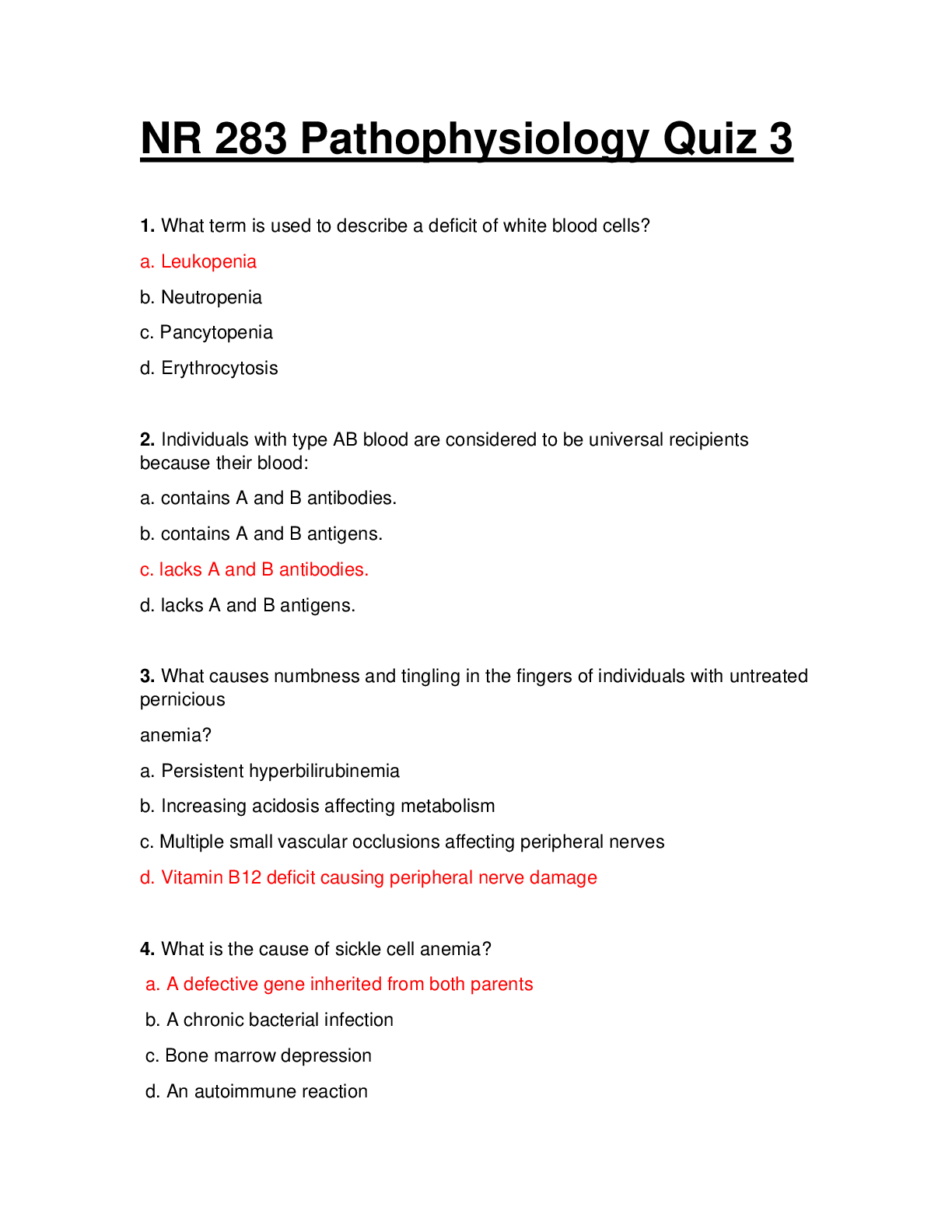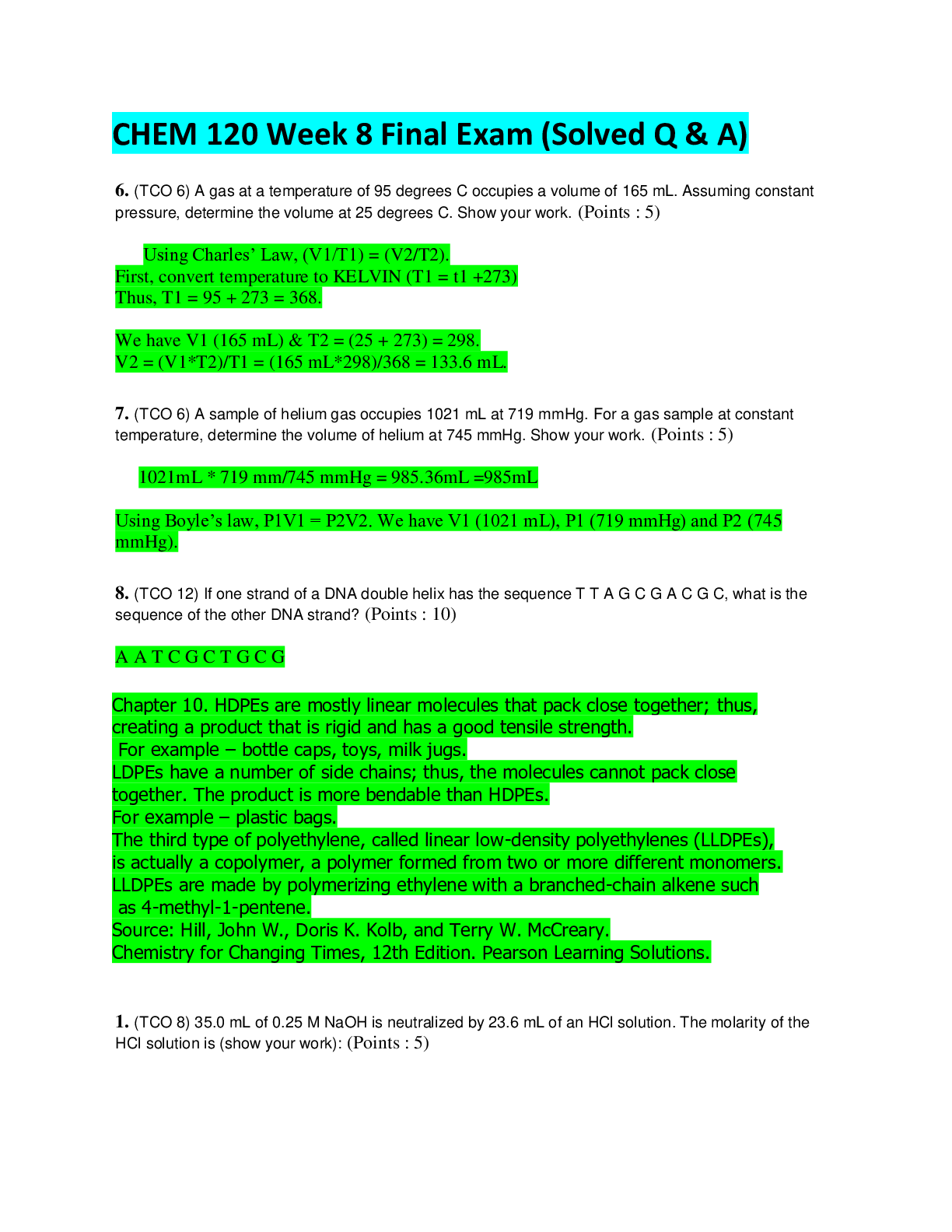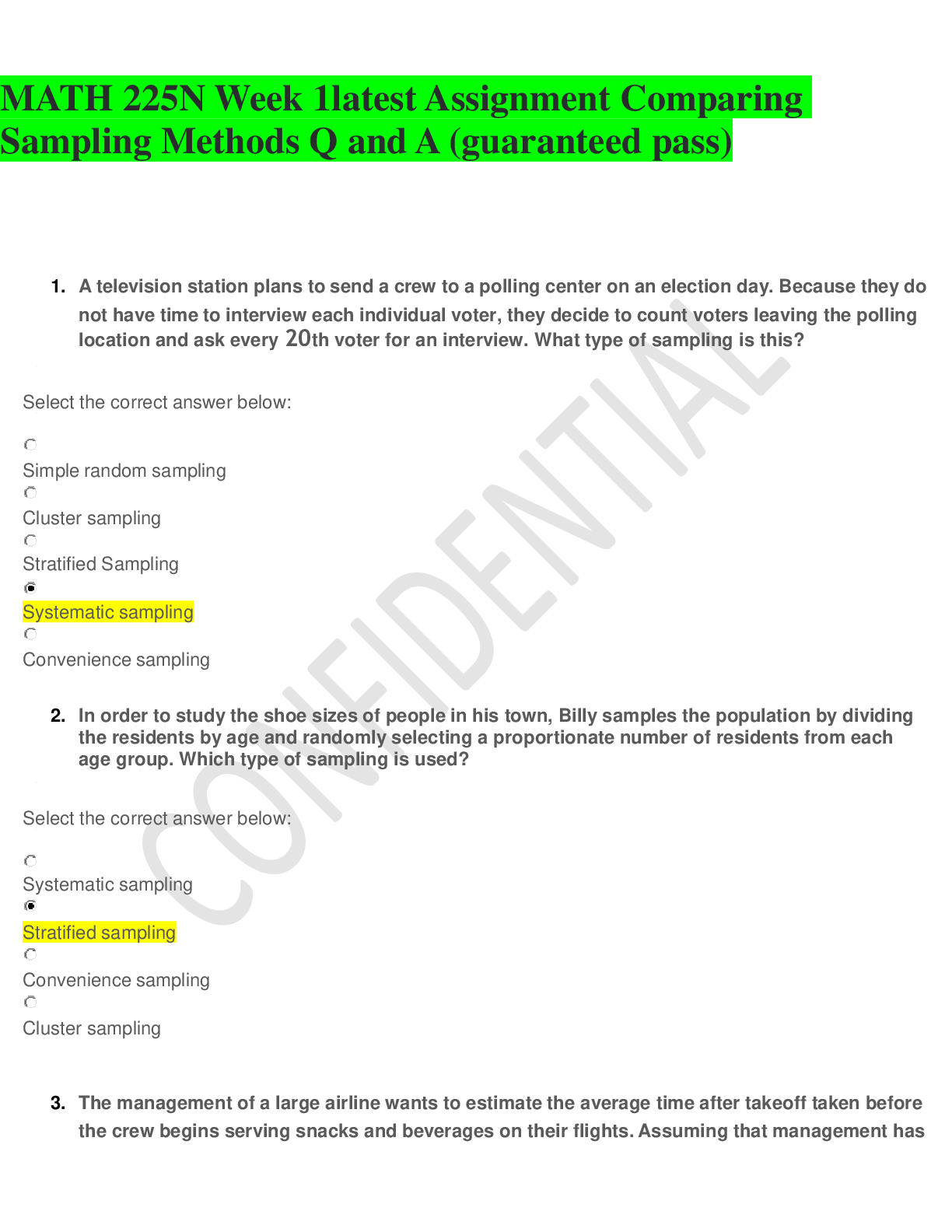*NURSING > QUESTIONS & ANSWERS > NURS 6640 Midterm Exam / NURS6640 Midterm Exam |3 Latest Versions-2020|75 Q & A in Each Version| Ver (All)
NURS 6640 Midterm Exam / NURS6640 Midterm Exam |3 Latest Versions-2020|75 Q & A in Each Version| Verified and 100 % Correct|Graded A
Document Content and Description Below
Question 1 1 out of 1 points A 35-year-old patient seeks treatment for depression and anxiety after an abusive relationship. To help empower the patient, the PMHNP wants to teach the safe-place ... exercise to create a feeling of calm. In order to walk the patient through the exercise, the PMHNP first says: • Question 2 1 out of 1 points The PMHNP is working with a patient who has dissociative disorder and requests pharmacological interventions for dealing with her trauma. What education does the PMHNP provide to the patient regarding medication therapy? • Question 3 1 out of 1 points The patient attempts the PMHNP’s sleep hygiene recommendations for 2 weeks, but does not make any progress mitigating nightmares and hyperarousal. Which behavioral strategy does the PMHNP suggest next? • Question 4 1 out of 1 points After informing a prospective patient about limits of confidentiality, the patient consents to the “conditions” of confidentiality and signs an informed consent form. Several weeks later, a lawyer representing the patient’s spouse for a court case, asks the PMHNP for the disclosure of information about the patient. The PMHNP should: • Question 5 1 out of 1 points The PMHNP meets with an adolescent patient who has depression and often presents with resistance when discussing his parent’s divorce. For the past couple of sessions, the patient has been quiet, sometimes refusing to speak. To further support the therapeutic relationship, the PMNHP: • Question 6 1 out of 1 points The PMHNP employs psychodynamic psychotherapy with a patient who experiences anxiety and depression. As the process enters the psychoanalytic end of the psychodynamic continuum, the PMNHP will focus on: • Question 7 1 out of 1 points The PMHNP is working with a patient who witnessed her father pass away after suffering for several months from terminal cancer. The PMHNP sees this as a traumatic event. The patient reports sometimes feeling out of touch with surroundings; almost as if things feel like a dream. “Sometimes that sensation lingers for a while,” the patient says, “and other times I snap out of it quickly.” What does the PMHNP infer about the condition based on psychotherapy concepts for trauma? 1 out of 1 points The PMHNP is working with a school-aged child who has been diagnosed with depression. The child has attended several sessions with the PMNHP, but recently presents with avoidant behavior by showing increased distress and being late to sessions. What approach does the PMHNP need to employ with the child to continue making therapeutic progress? • Question 9 1 out of 1 points An 11-year-old patient has been exhibiting low self-esteem at school and acting out. According to Maslow’s hierarchy of needs, which of the following questions would best be addressed first by the PMHNP? • Question 10 1 out of 1 points The PMHNP is working with a patient who experiences anxiety around her parents that later leads to poor impulse control. What will the PMHNP do to employ psychodynamic psychotherapy properly for this patient? • Question 11 1 out of 1 points The patient is a 56-year-old female patient diagnosed with panic disorder and reports symptoms that include heart palpitations, frequent trembling, and feelings of choking in stressful situations. What special consideration does the PMHNP make? • Question 12 1 out of 1 points The PMHNP is working with a veteran who has posttraumatic stress disorder (PTSD). The PMHNP believes that dual awareness will be beneficial in allowing the patient to focus on the here and now. What strategies can the PMHNP use to develop dual awareness in the patient? • Question 13 1 out of 1 points The PMHNP has been treating a 15-year-old patient with a history of abuse and neglect. Thirty minutes into their therapy session the patient jumps up and begins to pace around the room. Utilizing Socratic dialogue (SD) the PMHNP’s best action would be to: • Question 14 1 out of 1 points The PMHNP is caring for a patient with borderline personality disorder. Using a psychoanalytic psychotherapy approach, the PMHNP attempts to intensify the patient’s transference to enhance emotional processing by: • Question 15 0 out of 0 points When completing this exam, did you comply with Walden University’s Code of Conduct including the expectations for academic integrity? • Question 16 1 out of 1 points An initial evaluation reveals that an 11-year-old patient has moved to a new school after her parents’ recent divorce, and is having trouble making friends. The patient has normal mental status and exhibits appropriate behavior. What is the most appropriate scale for the PMHNP to use to get more information? • Question 17 1 out of 1 points A PMHNP is treating a 50-year-old patient who suffers from depression. When he was growing up, he was often responsible for taking care of his three younger siblings. Since then, the patient puts other people’s needs before his own. Based on this information, the PMHNP would conclude that his interpersonal style is __________. • Question 18 1 out of 1 points The PMHNP is assessing a patient who grew up in a foster home because she was neglected and abused by her birth parents at a young age. The patient admits to having difficulty forming and maintaining relationships throughout her life. Understanding maladaptive schemas, which statement does the PMHNP predict that the patient is likely to make? • Question 19 1 out of 1 points A 28-year-old male patient is experiencing distress related to the workplace. What might the PMHNP ask to assess affective development? • Question 20 1 out of 1 points The PMHNP is meeting with a new patient who is a young veteran back from serving two tours overseas. When reviewing the patient’s health history file that was sent from the VA, the PMHNP learns that several months ago, the patient was diagnosed with PTSD, but never followed up with treatment for it. After a comprehensive mental health assessment, the PMHNP confirms the PTSD diagnosis and understands that which therapeutic approach will be the most effective as a first-line treatment modality? • Question 21 1 out of 1 points An elderly patient in a nursing home has been losing interest in activities and now refuses to leave his room. After a physical exam, he is referred to a PMHNP for an initial assessment. True or false: After speaking with the patient, an appropriate screening tool for the PMHNP to use would be the Geriatric Depression Scale. • Question 22 1 out of 1 points A 65-year-old patient has suffered the loss of his wife. He is in a state of hyperarousal with increased sympathetic nervous system arousal. One or more interventions may help the patient to deal with this arousal. To decrease sympathetic nervous system arousal, the PMHNP’s treatment strategy is ___________. • Question 23 1 out of 1 points The PMHNP is treating a patient with a substantial fear of feeling closed in (claustrophobia). Thus, the patient will not get into an elevator. The office where he works is on the 10th floor and this requires that he walk up and down the stairs in the morning and evening to get to his office. With permission from the patient, the PMHNP is beginning systematic desensitization to address the patient’s need to use the elevator. What is the PMHNP’s best plan of action? • Question 24 1 out of 1 points The PMHNP has a session with a patient who was injured and traumatized from an explosion at the industrial plant where he used to work. During the session, an outside noise startles the patient and he experiences a flashback of the loud boom from the explosion. The PMHNP witnesses the patient present with anxiety and belabored breathing. What is the appropriate action of the PMHNP? • Question 25 1 out of 1 points When the patient comes into the office, she says, “I just saw a friend of mine out in the waiting room. What’s wrong with him?” The PMHNP says, “He’ll be fine. He has mild depression.” Which of the following statement is correct related to confidentiality rights? • Question 26 1 out of 1 points You are seeing a 29-year-old widow whose husband recently died overseas while serving his country in the military. She has been mourning the loss of her husband for several months, and continues to grieve. She refuses to go to group grieving sessions, but reports that she is still able to go to work and her fitness classes sometimes, and even makes attempts to stay social. She says, “Sometimes it’s like he’s not even gone. Other times it feels like it’s been an eternity since I’ve seen him. It’s hard to talk about this type of stuff with my girlfriends, especially since all of their husbands are still alive.” The PMHNP understands that it is appropriate to employ which therapeutic principle? • Question 27 1 out of 1 points A PMHNP is caring for a 21-year-old woman who is suffering from anxiety and is having difficulty managing stress. Which of the following would be an appropriate step by the PMHNP? • Question 28 1 out of 1 points The PMHNP is working with an adult patient who has somatic complaints caused by a history of childhood abuse. As part of the therapeutic process, what does the PMHNP do to assess and organize a trauma history? • Question 29 1 out of 1 points The PMHNP meets with a 47-year-old male patient who is fearful of leaving the house after having witnessed his neighbor getting run over by a car. When the PMHNP asks why he is afraid to leave his house, the patient replies, “Because another accident might occur.” Which cognitive behavioral therapy (CBT) strategy does the PMHNP employ? • Question 30 1 out of 1 points The PMHNP is working with a patient who seems dissatisfied with the therapeutic relationship. The PMHNP invites the patient to discuss her feelings regarding the PMHNP openly and honestly. It becomes clear to the PMHNP that they are experiencing an alliance rupture. How does the PMHNP repair the therapeutic alliance? • Question 31 1 out of 1 points Your patient is a 65-year-old male who has a strained relationship with his son and daughter. His children refuse to participate in a family session. The PMHNP asks the patient to draw his family genogram as a next step to _______________. • Question 32 0 out of 1 points The PMHNP is meeting with a 38-year-old divorced, single mother who has been seeing the PMHNP for anxiety and anger management. During one of the sessions, the patient tells the PMHNP that she is having a problem getting her child support payments from her ex-husband, which is triggering increased anxiety and anger, which she admittedly takes out on her children. How does the PMHNP respond in a way that upholds the supportive psychodynamic psychotherapy approach? • Question 33 1 out of 1 points The PMHNP is caring for a patient with dissociated self-state that the PMHNP identifies as being associated with traumatic experiences in the patient’s past. What approach does the PMHNP use with the patient that is crucial to the psychodynamic therapy process? [Show More]
Last updated: 2 years ago
Preview 1 out of 18 pages

Buy this document to get the full access instantly
Instant Download Access after purchase
Buy NowInstant download
We Accept:

Reviews( 0 )
$9.50
Can't find what you want? Try our AI powered Search
Document information
Connected school, study & course
About the document
Uploaded On
Jan 12, 2021
Number of pages
18
Written in
Additional information
This document has been written for:
Uploaded
Jan 12, 2021
Downloads
0
Views
100












.png)








.png)

 (LATEST-2020) 100% CORRECT ANSWERS, DOWNLOAD TO SCORE A.png)


